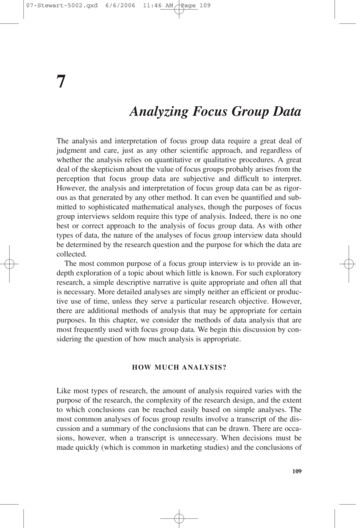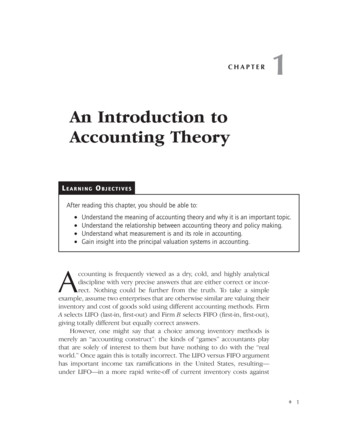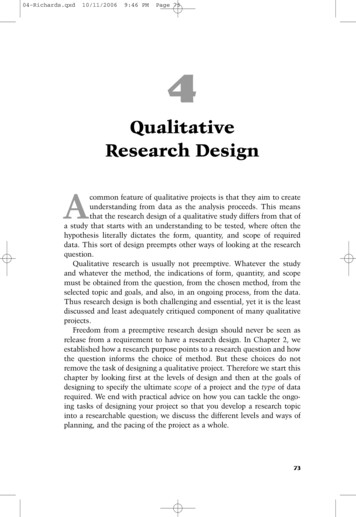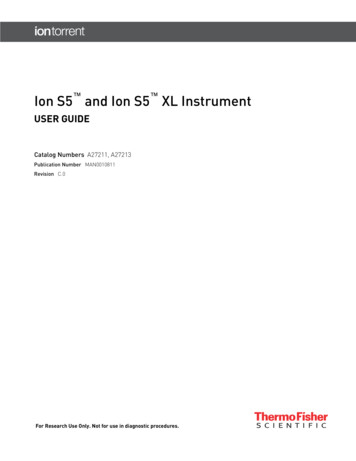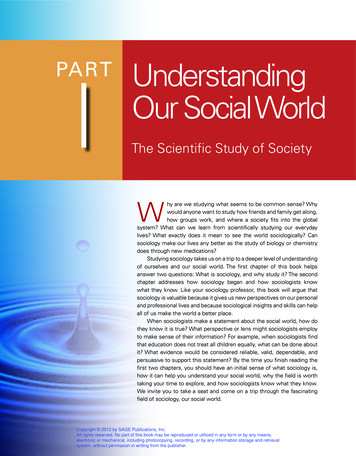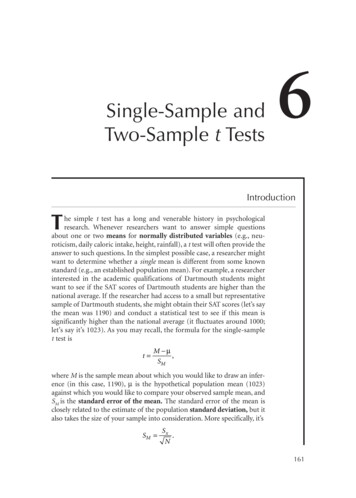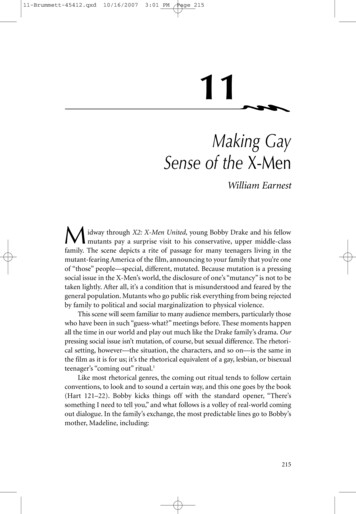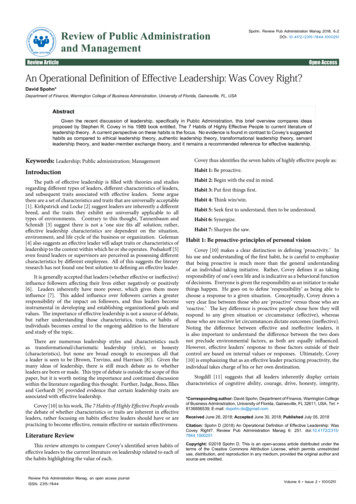
Transcription
tw of PublicvieReanagemendManministrationAdISSN: 2315-7844Review of Public Administrationand ManagementSpohn. Review Pub Administration Manag 2018, 6:2DOI: 10.4172/2315-7844.1000251Review ArticleOpen AccessAn Operational Definition of Effective Leadership: Was Covey Right?David Spohn*Department of Finance, Warrington College of Business Administration, University of Florida, Gainesville, FL, USAAbstractGiven the recent discussion of leadership, specifically in Public Administration, this brief overview compares ideasproposed by Stephen R. Covey in his 1989 book entitled, The 7 Habits of Highly Effective People to current literature ofleadership theory. A current perspective on these habits is the focus. No evidence is found in contrast to Covey’s suggestedhabits as compared to ethical leadership theory, authentic leadership theory, transformational leadership theory, servantleadership theory, and leader-member exchange theory, and it remains a recommended reference for effective leadership.Keywords: Leadership; Public administration; ManagementCovey thus identifies the seven habits of highly effective people as:IntroductionHabit 1: Be proactive.The path of effective leadership is filled with theories and studiesregarding different types of leaders, different characteristics of leaders,and subsequent traits associated with effective leaders. Some arguethere are a set of characteristics and traits that are universally acceptable[1]. Kirkpatrick and Locke [2] suggest leaders are inherently a differentbreed, and the traits they exhibit are universally applicable to alltypes of environments. Contrary to this thought, Tannenbaum andSchmidt [3] suggest there is not a ‘one size fits all’ solution; rather,effective leadership characteristics are dependent on the situation,environment, and life cycle of the business or organization. Goleman[4] also suggests an effective leader will adapt traits or characteristics ofleadership to the context within which he or she operates. Podsakoff [5]even found leaders or supervisors are perceived as possessing differentcharacteristics by different employees. All of this suggests the literaryresearch has not found one best solution to defining an effective leader.It is generally accepted that leaders (whether effective or ineffective)influence followers affecting their lives either negatively or positively[6]. Leaders inherently have more power, which gives them moreinfluence [7]. This added influence over followers carries a greaterresponsibility of the impact on followers, and thus leaders becomeinstrumental in developing and establishing organizational goals andvalues. The importance of effective leadership is not a source of debate,but rather understanding those characteristics, traits, or habits ofindividuals becomes central to the ongoing addition to the literatureand study of the topic.There are numerous leadership styles and characteristics suchas transformational/charismatic leadership (style), or honesty(characteristics), but none are broad enough to encompass all thata leader is seen to be (Brown, Trevino, and Harrison [8]). Given themany ideas of leadership, there is still much debate as to whetherleaders are born or made. This type of debate is outside the scope of thispaper, but it is worth noting the importance and continued discussionwithin the literature regarding this thought. Further, Judge, Bono, Illiesand Gerhardt [9] provided evidence that certain leadership traits areassociated with effective leadership.Covey [10] in his work, The 7 Habits of Highly Effective People avoidsthe debate of whether characteristics or traits are inherent in effectiveleaders, rather focusing on habits effective leaders should have or arepracticing to become effective, remain effective or sustain effectiveness.Habit 2: Begin with the end in mind.Habit 3: Put first things first.Habit 4: Think win/win.Habit 5: Seek first to understand, then to be understood.Habit 6: Synergize.Habit 7: Sharpen the saw.Habit 1: Be proactive-principles of personal visionCovey [10] makes a clear distinction in defining ‘proactivity.’ Inhis use and understanding of the first habit, he is careful to emphasizethat being proactive is much more than the general understandingof an individual taking initiative. Rather, Covey defines it as takingresponsibility of one’s own life and is indicative as a behavioral functionof decisions. Everyone is given the responsibility as an initiator to makethings happen. He goes on to define ‘responsibility’ as being able tochoose a response to a given situation. Conceptually, Covey draws avery clear line between those who are ‘proactive’ versus those who are‘reactive.’ The key difference is proactive people chose how they willrespond to any given situation or circumstance (effective), whereasthose who are reactive let circumstances dictate outcomes (ineffective).Noting the difference between effective and ineffective leaders, itis also important to understand the difference between the two doesnot preclude environmental factors, as both are equally influenced.However, effective leaders’ response to those factors outside of theircontrol are based on internal values or responses. Ultimately, Covey[10] is emphasizing that as an effective leader practicing proactivity, theindividual takes charge of his or her own destination.Stogdill [11] suggests that all leaders inherently display certaincharacteristics of cognitive ability, courage, drive, honesty, integrity,*Corresponding author: David Spohn, Department of Finance, Warrington Collegeof Business Administration, University of Florida, Gainesville, FL 32611, USA, Tel: 8136856539; E-mail: dspohn.ds@gmail.comReceived June 26, 2018; Accepted June 30, 2018; Published July 05, 2018Literature ReviewCitation: Spohn D (2018) An Operational Definition of Effective Leadership: WasCovey Right?. Review Pub Administration Manag 6: 251. doi:10.4172/23157844.1000251This review attempts to compare Covey’s identified seven habits ofeffective leaders to the current literature on leadership related to each ofthe habits highlighting the value of each.Copyright: 2018 Spohn D. This is an open-access article distributed under theterms of the Creative Commons Attribution License, which permits unrestricteduse, distribution, and reproduction in any medium, provided the original author andsource are credited.Review Pub Administration Manag, an open access journalISSN: 2315-7844Volume 6 Issue 2 1000251
Citation: Spohn D (2018) An Operational Definition of Effective Leadership: Was Covey Right?. Review Pub Administration Manag 6: 251.doi:10.4172/2315-7844.1000251Page 2 of 6motivation, and self-confidence. Lord et al. [1] conclude the same.While many of these characteristics are important, and may very well begeneralized across leaders, Covey focuses on one of these characteristicsin his first habit of proactivity. Similarly, the literature supports thisin Stogdill [11] and Lord et al.’s [1] findings of drive and motivation.Extant literature also lends support to this habit [2,12-14] as prominenttraits of leaders. These two characteristics or habits as Covey conveys,are what defines proactivity, along with the trait of responsibility.However, this is only supported in two of the central leadership theories(ethical leadership theory and transformational leadership theory).Habit 2: Begin with the end in mind-principles of personalleadershipCovey’s second habit [10] is a visualization exercise where heencourages individuals to begin an event at the destination. Histhought process includes glancing into the future to understand whereyou want to be before you start the decision or decisions that willaffect an individual’s path. This has many beneficial characteristics, asbeginning at the destination helps the individual grasp the beginningpoint, understand where the individual currently resides in the decisionprocess (and understanding surroundings), and gives the individuala path to follow, ensuring success throughout each decision point.Covey’s argument for this habit resides in the fact that as peoplebecome busy with normal happenings or unusual circumstances, it isoften very easy to become distracted with the almost infinite variablesthat could change an individual’s course. These distractions becomeactive actions that mislead and are contrary to interests or intentions ofthe ultimate goal. This visionary exercise becomes a key determinantin accomplishing goals, and an effective measure of success. As aproponent of this principle, the first step in ‘creation’ is to mentallygrasp the outcome.As a component of transformational leadership theory, the leaderand follower share a relationship built on trust [15]. In placing theirtrust in the leader, the subordinate also places a considerable amountof confidence in their leader [16]. Bass [17] suggests that charisma,individual consideration, inspiration, and intellectual stimulation asthe four key components of a transformational leader. This idea ofinspiration (from the leader to the follower) is realized through theability to relate an idea or end state. The ability to influence the followerthrough inspiration is predicated through the leader’s visionary prowess[17]. Because vision is a key concept of leadership [18-25], leaders arethus forced to take an abstract idea in their minds and incorporate thoseideas to others [26], giving Covey’s second habit legitimacy. In additionto transformational leadership theory, servant leadership theory alsosupports this idea through leader foresight [27].Habit 3: Put first things first-principles of personal managementCovey’s [10] second habit is to first use imagination, then to visualize.His third habit is the realization of that imagination. He stressesthis habit is responsible for the actual creation of the visualization.Building on the two previous habits, Covey emphasizes the individual’spropensity to take control, conceptually understand where he/she isgoing, and the third step of actualization revolves around prioritizingor managing an individual’s self. To accomplish goals, Covey suggestsa systematic way to reduce time with ‘not urgent’ and ‘not important’tasks that inherently present themselves throughout each day or week.Prioritizing time spent with ‘urgent’ and ‘important’ tasks each weekwill inevitably free an individual by ‘putting first things first’ which leadsan individual down the path to effectiveness.Review Pub Administration Manag, an open access journalISSN: 2315-7844Being able to prioritize based on a Covey’s quadrant meansdelegation of certain tasks to others to ensure effectiveness. Yukl [28]seems to agree, as his research found among others, that participativebehaviors including delegation of authority, setting expectations ofperformance and facilitation of decision making all are behaviors inwhich leaders display.Ashley and Patel [29] find leadership who focus on total qualityor efficiency is a significant factor in determining successful companyperformance.They further emphasize leaders who focus oncommunication as well as quality produce successful firms. This is animportant concept that falls in line with Covey. The habit of ‘puttingfirst things first’ is just another way to define efficiency, as Coveyemphasizes reducing time wasted on ‘not urgent’ and ‘not important’tasks. This focus inevitably becomes centered on efficiency or timespent on meaningful tasks, which inherently leads to effectiveness.Several leadership theories also elude to the importance of priorityas in leader-member exchange theory and servant leadership theory[30,31]. While neither theory inherently addresses priority in the waythat Covey suggests (setting priorities for efficiency), both theoriesshare it as a construct in the relationship between leader and follower[32]. Additional studies show this increase in prioritization aid indepartmental success [33].Habit 4: Think win/win-principles of interpersonal leadershipGiven the unique relationship between leader and follower, leadershave influence over those who follow them [6]. This influence becomescentral to Covey’s [10] fourth habit. Being in a leadership role has manyadvantages and responsibilities. One of those responsibilities underCovey’s habit is under the dichotomy of moving from independence tointerdependence. This interdependence of a leader and follower involvesthe idea of an effective interpersonal relationship. The responsibilityof the leader then becomes to ‘think win/win.’ Covey emphasizes thismentality (or habit) is one of six different decisions encompassing:Win/Win, Win/Lose, Lose/Win, Lose/Lose, Win, and Win/Win or NoDeal. Covey goes on to argue that Win/Win is a simple frame of mindthat seeks solutions which are mutually beneficial to all parties involved.Decisions or circumstances that preclude the Win/Win solutionbecome predicated on an abuse of power or position. Decisions madeon principle become central to the success of all parties involved and aregenerally viewed as mutually beneficial. This idea eliminates the successof one at another’s expense. Rather, it is a method, effective leaders useto enhance the capabilities of those surrounding them.Obviously, there are many skills effective leaders need to besuccessful, but interpersonal skills are extremely important, assupported in ethical leadership theory, authentic leadership theory,transformational leadership theory, servant leadership theory andleader-member exchange theory. Covey makes it inherently clear thatin order to think Win/Win, interpersonal skills of a leader are essential.Yukl [28] also agrees and concludes interpersonal and conceptual skillsare inherent traits of an effective leader, as well as technical skills.In considering a Win/Win scenario as Covey suggests, leadersand followers look to exercise a mutually beneficial arrangement.Pettigrew [34] coffers an example where leaders should look toleverage this mentality when controlling a piece of vital
proposed by Stephen R. Covey in his 1989 book entitled, The 7 Habits of Highly Effective People to current literature of leadership theory. A current perspective on these habits is the focus. No evidence is found in contrast to Covey’s suggested habits as compared to ethical leadership theory, authentic leadership theory, transformational leadership theory, servant leadership theory, and .
